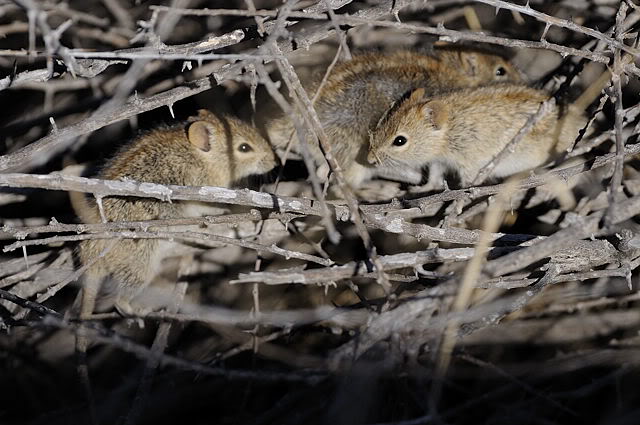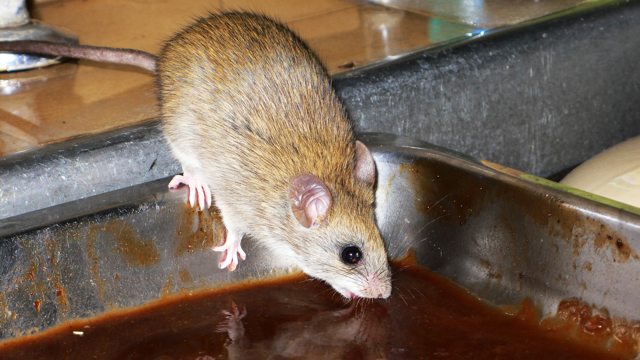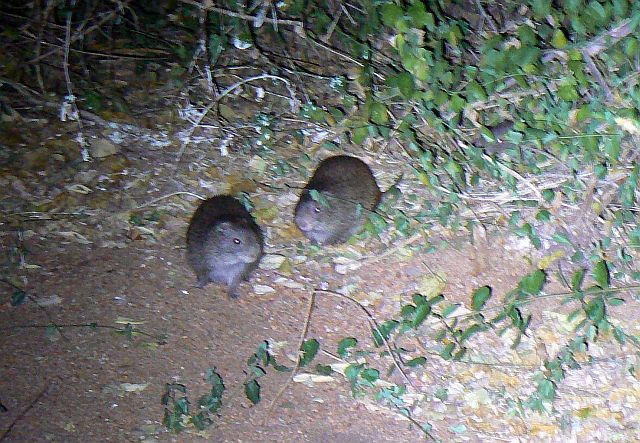
Mice and Rats
Re: Mice and Rats - Animal of the Month: May 2014
Striped Mice, KTP.


Dewi
What is the good of having a nice house without a decent planet to put it on? (H D Thoreau)
What is the good of having a nice house without a decent planet to put it on? (H D Thoreau)
- nan
- Posts: 26489
- Joined: Thu May 31, 2012 9:41 pm
- Country: Switzerland
- Location: Central Europe
- Contact:
Re: Mice and Rats - Animal of the Month: May 2014
the first ones... I'm still not ready
Kgalagadi lover… for ever
https://safrounet.piwigo.com/
https://safrounet.piwigo.com/
Re: Mice and Rats - Animal of the Month: May 2014
And another....


Dewi
What is the good of having a nice house without a decent planet to put it on? (H D Thoreau)
What is the good of having a nice house without a decent planet to put it on? (H D Thoreau)
Re: Mice and Rats - Animal of the Month: May 2014
Rat, Bateleur camp.
"Good Gravy" is the term you Saffies use I think?

"Good Gravy" is the term you Saffies use I think?

Dewi
What is the good of having a nice house without a decent planet to put it on? (H D Thoreau)
What is the good of having a nice house without a decent planet to put it on? (H D Thoreau)
- nan
- Posts: 26489
- Joined: Thu May 31, 2012 9:41 pm
- Country: Switzerland
- Location: Central Europe
- Contact:
Re: Mice and Rats - Animal of the Month: May 2014
Dewi wrote:Rat, Bateleur camp.
"Good Gravy" is the term you Saffies use I think?
Kgalagadi lover… for ever
https://safrounet.piwigo.com/
https://safrounet.piwigo.com/
- Mel
- Global Moderator
- Posts: 26737
- Joined: Sat May 19, 2012 12:31 pm
- Country: Germany
- Location: Föhr
- Contact:
Re: Mice and Rats - Animal of the Month: May 2014
What kind of good gravy rat is it? Acacia Tree?
God put me on earth to accomplish a certain amount of things. Right now I'm so far behind that I'll never die.
Re: Mice and Rats - Animal of the Month: May 2014
Greater Cane Rat Thryonomys swinderianus

Geographic Range
Common in Africa, south of the Sahara. It ranges from Gambia to southern Sudan and from south to north Namibia and South Africa. Its range does not include the southwest portion of South Africa.
Habitat
Near marshes and river banks, in plantations of cultivated crops.
Physical Description
The body length is usually 35-61 cm, and their tail reaches 6- 26 cm in length. Great Cane Rats’ heavyset bodies have an average weight in males of 4.5 kg and 3.5 kg in females. They have a rounded nose, short ears, and incisors that grow continuously. The pelage is coarse, with flattened bristle like hairs that grow in groups of five or six. The upper parts are a yellowish brown color and the underside is a much lighter gray. Great Cane Rats have no under fur. The forefeet are smaller than the hind feet and have three well developed middle digits with the first and fifth digits greatly reduced. The hind feet have no first digit and all digits have heavy claws.
Reproduction
They live in groups of males and females during the breeding season. When the dry season comes males separate from the group and live by themselves. The females continue to live together.
The wet season of the year is the usual breeding season. Females generally have two litters per year with usually 4 offspring. Great Cane Rats estrous cycle usually lasts 6.62 days and they have a gestation period of 137- 172 days. Offspring weigh about 129 grams and are relatively well developed. Their eyes are open, they are covered in hair and can run. T. swinderianus become sexually mature at about a year old.
Behavior
T. swinderianus can be usually found in groups composed of one male, several females, and young from more than one generation. They are nocturnal and create trails through grass and reeds that lead from shelter to feeding and water sites. They pound down tall grass to make nests and also make shallow burrows for shelter. They are good swimmers and divers. If Great Cane Rats become afraid they either stomp their hind feet and grunt or quickly run towards water. Fitzinger (1997) describes males fighting by having a nose to nose pushing duel. He did not observe males fighting with females or young.
Diet
They are herbivores and their natural diet is mainly grasses and cane. Sometimes they also eat bark, fallen fruits, nuts and many different kinds of cultivated crops (sugar cane, maize, millet, cassava, roundnuts, sweet potatoes, and pumpkins). Great Cane Rats’ favorite food is elephant grass and sweet potatoes. They prefer plants with lots of moisture and soluble carbohydrates.

Geographic Range
Common in Africa, south of the Sahara. It ranges from Gambia to southern Sudan and from south to north Namibia and South Africa. Its range does not include the southwest portion of South Africa.
Habitat
Near marshes and river banks, in plantations of cultivated crops.
Physical Description
The body length is usually 35-61 cm, and their tail reaches 6- 26 cm in length. Great Cane Rats’ heavyset bodies have an average weight in males of 4.5 kg and 3.5 kg in females. They have a rounded nose, short ears, and incisors that grow continuously. The pelage is coarse, with flattened bristle like hairs that grow in groups of five or six. The upper parts are a yellowish brown color and the underside is a much lighter gray. Great Cane Rats have no under fur. The forefeet are smaller than the hind feet and have three well developed middle digits with the first and fifth digits greatly reduced. The hind feet have no first digit and all digits have heavy claws.
Reproduction
They live in groups of males and females during the breeding season. When the dry season comes males separate from the group and live by themselves. The females continue to live together.
The wet season of the year is the usual breeding season. Females generally have two litters per year with usually 4 offspring. Great Cane Rats estrous cycle usually lasts 6.62 days and they have a gestation period of 137- 172 days. Offspring weigh about 129 grams and are relatively well developed. Their eyes are open, they are covered in hair and can run. T. swinderianus become sexually mature at about a year old.
Behavior
T. swinderianus can be usually found in groups composed of one male, several females, and young from more than one generation. They are nocturnal and create trails through grass and reeds that lead from shelter to feeding and water sites. They pound down tall grass to make nests and also make shallow burrows for shelter. They are good swimmers and divers. If Great Cane Rats become afraid they either stomp their hind feet and grunt or quickly run towards water. Fitzinger (1997) describes males fighting by having a nose to nose pushing duel. He did not observe males fighting with females or young.
Diet
They are herbivores and their natural diet is mainly grasses and cane. Sometimes they also eat bark, fallen fruits, nuts and many different kinds of cultivated crops (sugar cane, maize, millet, cassava, roundnuts, sweet potatoes, and pumpkins). Great Cane Rats’ favorite food is elephant grass and sweet potatoes. They prefer plants with lots of moisture and soluble carbohydrates.
- Richprins
- Committee Member
- Posts: 75450
- Joined: Sat May 19, 2012 3:52 pm
- Location: NELSPRUIT
- Contact:
Re: Mice and Rats - Animal of the Month: May 2014
Only had one mouse sighting...in Shingwedzi...
The thing came and attacked our leftover chop bones and eventually other meat offered....never knew they were carnivorous!


The thing came and attacked our leftover chop bones and eventually other meat offered....never knew they were carnivorous!
Please check Needs Attention pre-booking: https://africawild-forum.com/viewtopic.php?f=322&t=596
- nan
- Posts: 26489
- Joined: Thu May 31, 2012 9:41 pm
- Country: Switzerland
- Location: Central Europe
- Contact:
Re: Mice and Rats - Animal of the Month: May 2014
I start very strong... I don't even know the name 

seen in Tanzania, Manyara Lake... quite big
 2.5.2003
2.5.2003
seen in Tanzania, Manyara Lake... quite big
 2.5.2003
2.5.2003Kgalagadi lover… for ever
https://safrounet.piwigo.com/
https://safrounet.piwigo.com/
- Flutterby
- Posts: 44029
- Joined: Sat May 19, 2012 12:28 pm
- Country: South Africa
- Location: Gauteng, South Africa
- Contact:
Re: Mice and Rats - Animal of the Month: May 2014
They are actually quite sweet...if they don't come too close! 



